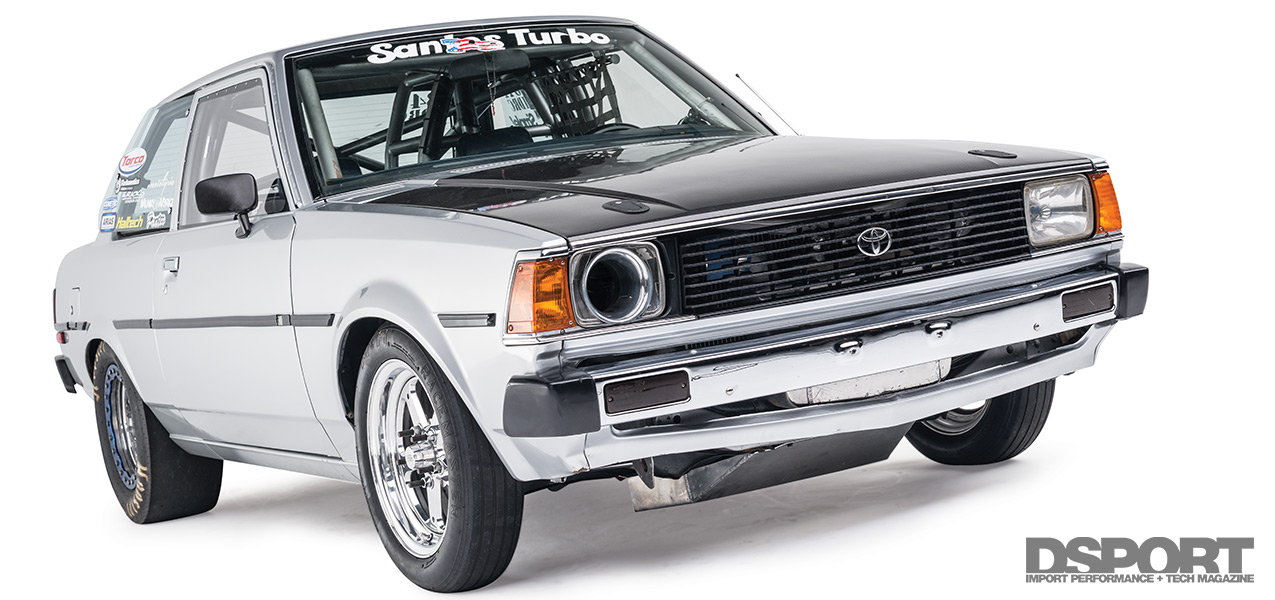 The TACOrolla
The TACOrolla
While the previous engine was transplanted from a TE72 Corolla, Santos decided to build upon a popular engine from the Toyota Tacoma, the 2.4-liter, four-cylinder 2RZ-FE. Within the Tacoma community, this is the most popular engine to turbocharge, and many have done so with great success. Thus, a clean block formed the foundation of the new drivetrain. Santos had the block honed by Vellios Machine Shop before he dropped in a set of 8.5:1 compression Arias pistons joined to the factory crank by way of Pauter connecting rods. Before mating the cylinder head to the block, it received a port and polish service by Joe Alaniz. Alaniz also installed a complete LC Engineering valvetrain in preparation for a set of higher lift Web camshafts.
Double Up On Power
Although the 3T-C relied on forced induction and nitrous oxide injection to help bump up the output, Santos wanted to make big power with forced induction alone this time. A Randy Heinlin Design custom exhaust manifold channels the exhaust gasses into a Turbonetics turbocharger. After working extensively with Turbonetics to develop this turbo, it was dubbed the “T76 Santos Turbo Spec” turbocharger. This T4 based turbo generates the boost pressure that Santos would need to reach his goal of single-digit passes. A highly efficient air-to-water intercooler helped to reduce the temperature of the intake charge as it flows through a Gato Performance intake manifold for distribution to the intake ports. A set of Bosch 1,600cc/min injectors spray VP Racing C16 racing fuel into the combustion chambers. With a Haltech Elite 2500 engine management regulating fuel delivery along with the ignition timing to the Haltech high-output inductive coils, Santos called upon his friend Rafael Fuentes Jr. of Auto Authority to take a trip to Southern California to refine and optimize the tables. Fuentes tuned many of the 3T-C powered vehicles on the east coast, and since he had also tuned the 2RZ-FEs, he was Santos’ tuner of choice.
It was now time to put the build to the test. Their goal was to aim for a nine-second pass. The first pass off the trailer, Santos ran a 9.5-second e.t. Thus, they aimed a little higher, with sights set on eights. This was not quite a simple task, as the plan was to continue using a 26×8.5-inch tire. This proved quite a challenge as managing the power delivery required a lot of testing and adjustments. MunkyW3rkz Fabrication (Santos Jr.’s side business) customized the front struts and made custom rear control arms and diagonal links. A set of Viking two-way adjustable dampers manages the squat at the back. Several sets of QA1 springs were tested before the right combination was in place. Trying out several sets of tires also added to the challenge, but Hoosier slicks ended up being the ideal rubber to put on the pavement. As Santos dialed in the chassis, Fuentes adjusted and tuned the engine for 40-psi boost pressure. But the Corolla maxed out the dyno. At 28 psi, horsepower checked in at 820, but at a max boost of 40 psi, it was estimated at 950.

 3T-C vs. 2RZ-FE
3T-C vs. 2RZ-FE
Santos’ TE72 Corolla engine made some amazing power considering that it was based on 1,770cc of displacement, two overhead valves per cylinder and late 1970’s engine technology. But it was not without merit, as it featured a stout iron block and managed to produce more than four times the factory horsepower output thanks to both a turbocharger and nitrous oxide injection. However, there simply isn’t a comparison against the Tacoma’s 16 valve, dual overhead cam 2RZ-FE, which is a modern fuel injected engine nearly 20 years younger than the 3T-C. Not only does the 2RZ-FE benefit from a modern design, it is also of a much larger displacement at 2,439cc. Combined with the larger turbo and proper tuning, it nearly doubled the output of the previous engine.
Crushing Personal Records
Santos ended the 2013 season with a personal best pass of 8.75 at 159 mph. Breaking into the eights was already an accomplishment, but Santos wanted to be quicker and the Corolla responded. With enough power in place, the only variables that Santos adjusted to improve traction were the suspension and the boost controller. The AE71 continued to perform better with each passing event. At Bakersfield he ran an 8.62 elapsed time, and then at an IFO event he ran an 8.43. Then, at the IDRC International Finals on October 18, 2014, Santos started the day off with a scorching 8.41 second e.t. With each pass that day, small changes were made to the boost controller, and Santos got quicker. After running an 8.38, he capped the day off with an 8.35 second pass at 166 mph, his new personal best. He went on to win in the Outlaw Class, beating his opponent in the finals with an 8.48-second slip. While at the IDRC Finals, Santos’ passion and support for drag racing could be witnessed in all aspects of his racing efforts, as he even assisted the IDRC’s Director Michael Ferrara with a beginner’s drag racing seminar, contributing some of his experience and passion to the students on the first day of the IDRC Finals weekend.


